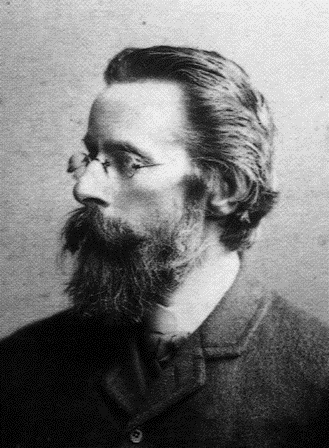Presents
Heinrich von Herzogenberg
|
Soundbites String Trio No.1 |
 |
Soundbites String Trio No.2 |
The String Trios for Violin, Viola & Cello
No.1 in A Major, Op.27 No.1 / No.2 in F Major, Op.27 No.2
The Austrian composer Heinrich von Herzogenberg (1843-1900) was often written-off as nothing more than a pale imitation of Brahms, of whom he was a great admirer. There is no denying that his music often strongly shows the influence of Brahms, however, listeners and players alike, who have revisited the music, have discovered that it is original and fresh, notwithstanding the influence of Brahms. Many compositions, especially his chamber music, are first rate and Brahms might well have wished he had written some of them. Toward the of his life, Brahms, who was not in the habit of praising other composers publicly, wrote of Herzogenberg, whom he had often harshly criticized in the past, “Herzogenberg is able to do more than any of the others."
Herzogenberg’s two string trios were written one after another and completed in 1877. They are both big works and among the few which Brahms publicly praised. No major composer (including Brahms) had, since Beethoven, published string trios. (Schubert’s remained in manuscript awaiting publication) So, it is not surprising that Beethoven was to serve as Herzogenberg’s structural model.
|
Notes to String Trio No.1 |
Notes to String Trio No.2 |
|
The opening subject to the first movement of String Trio No.1, Op.27 No.1 in A Major, Allegro, is bright, graceful and syncopated. The second theme, is equally cheerful, but somewhat broader and is sounds especially well in the viola and cello.
The Andante which follows begins with a beautiful folk melody, slow and lyrical, while the middle section is quicker and somewhat turbulent.
Next comes an Allegretto, which for its main theme has a kind of “Shepherd’s Lament” which quickly morphs into a rustic peasant’s dance.
The mood of the finale, Allegro, is similar to that of the 1st movement, mostly bright and graceful. Toward the end, the writing becomes almost orchestral which is quite an accomplishment for just three voices.
It is truly a shame that it is not better known. Parts: $19.95 |
The opening to String Trio No.2, Op.27 No.2 in F begins with the cello, all by itself, quietly introducing the first theme pizzicato. The bowed version is presented thereafter by the viola. When the violin enters, it becomes clear that this is a fugue, after which the theme receives canonic treatment. The second theme is dark, more chromatic and so intricately woven into the fabric of the first that it is hard to hear where one begins and the other ends. The Andantino, which follows, has the same format as the slow movement of 1st Trio. A lied presented entirely by the violin and again it is followed by a piu mosso section, the theme to which has the quality of a barcarole. These rolling 16th notes eventually become accompaniment to a cello melody. A Tempo di Minuetto comes next. It begins with an old-fashioned and somewhat dry melody of the sort to which 18th century French aristocrats might dance. The second strain, partially in minor, is more robust. The trio section, rather than being slower, is marked Piu vivo. Its lovely melody is sung by the violin and then later appears in cello as part of the coda. It is accompanied by the striking use of bariolage in the other voices. The very fine finale, Allegro vivace, begins with a truncated fugal version of the energetic first theme. The second is more lyrical and quite exotic and oriental-sounding. (our sound-bite starts at the end of the first theme and includes part of the second)
This trio, along with its companion No.1, must be considered among the best written for this combination. Parts: $19.95
|